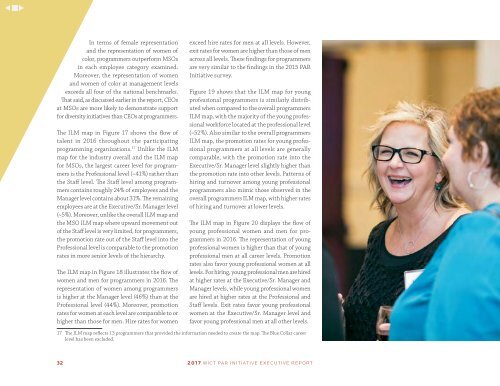Compendium Test
This is a test for the Compendium
This is a test for the Compendium
- No tags were found...
Create successful ePaper yourself
Turn your PDF publications into a flip-book with our unique Google optimized e-Paper software.
In terms of female representation<br />
and the representation of women of<br />
color, programmers outperform MSOs<br />
in each employee category examined.<br />
Moreover, the representation of women<br />
and women of color at management levels<br />
exceeds all four of the national benchmarks.<br />
That said, as discussed earlier in the report, CEOs<br />
at MSOs are more likely to demonstrate support<br />
for diversity initiatives than CEOs at programmers.<br />
The ILM map in Figure 17 shows the flow of<br />
talent in 2016 throughout the participating<br />
programming organizations. 17 Unlike the ILM<br />
map for the industry overall and the ILM map<br />
for MSOs, the largest career level for programmers<br />
is the Professional level (~41%) rather than<br />
the Staff level. The Staff level among programmers<br />
contains roughly 24% of employees and the<br />
Manager level contains about 31%. The remaining<br />
employees are at the Executive/Sr. Manager level<br />
(~5%). Moreover, unlike the overall ILM map and<br />
the MSO ILM map where upward movement out<br />
of the Staff level is very limited, for programmers,<br />
the promotion rate out of the Staff level into the<br />
Professional level is comparable to the promotion<br />
rates in more senior levels of the hierarchy.<br />
The ILM map in Figure 18 illustrates the flow of<br />
women and men for programmers in 2016. The<br />
representation of women among programmers<br />
is higher at the Manager level (46%) than at the<br />
Professional level (44%). Moreover, promotion<br />
rates for women at each level are comparable to or<br />
higher than those for men. Hire rates for women<br />
exceed hire rates for men at all levels. However,<br />
exit rates for women are higher than those of men<br />
across all levels. These findings for programmers<br />
are very similar to the findings in the 2015 PAR<br />
Initiative survey.<br />
Figure 19 shows that the ILM map for young<br />
professional programmers is similarly distributed<br />
when compared to the overall programmers<br />
ILM map, with the majority of the young professional<br />
workforce located at the professional level<br />
(~52%). Also similar to the overall programmers<br />
ILM map, the promotion rates for young professional<br />
programmers at all levels are generally<br />
comparable, with the promotion rate into the<br />
Executive/Sr. Manager level slightly higher than<br />
the promotion rate into other levels. Patterns of<br />
hiring and turnover among young professional<br />
programmers also mimic those observed in the<br />
overall programmers ILM map, with higher rates<br />
of hiring and turnover at lower levels.<br />
The ILM map in Figure 20 displays the flow of<br />
young professional women and men for programmers<br />
in 2016. The representation of young<br />
professional women is higher than that of young<br />
professional men at all career levels. Promotion<br />
rates also favor young professional women at all<br />
levels. For hiring, young professional men are hired<br />
at higher rates at the Executive/Sr. Manager and<br />
Manager levels, while young professional women<br />
are hired at higher rates at the Professional and<br />
Staff levels. Exit rates favor young professional<br />
women at the Executive/Sr. Manager level and<br />
favor young professional men at all other levels.<br />
17 The ILM map reflects 13 programmers that provided the information needed to create the map. The Blue Collar career<br />
level has been excluded.<br />
32 2017 WICT PAR INITIATIVE EXECUTIVE REPORT


